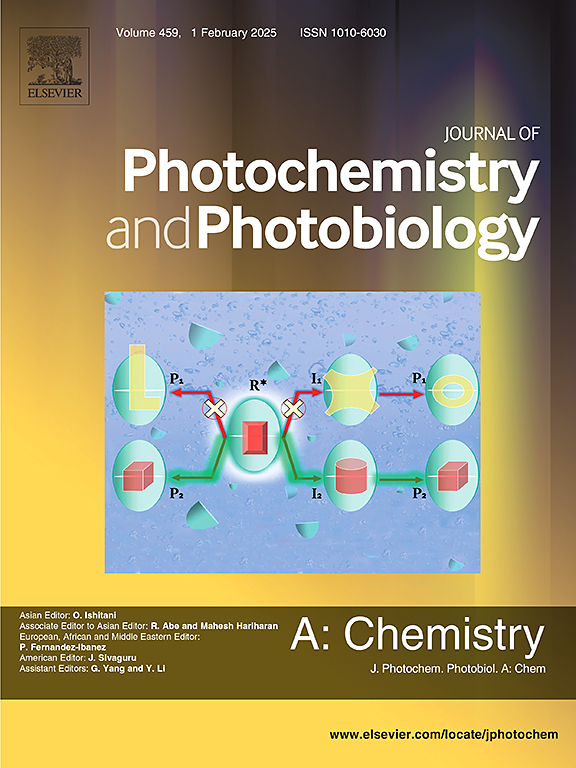Alicycloimide substitution strategy for realizing solution-Processable small molecules material with thermally activated delayed fluorescence
IF 4.1
3区 化学
Q2 CHEMISTRY, PHYSICAL
Journal of Photochemistry and Photobiology A-chemistry
Pub Date : 2025-07-08
DOI:10.1016/j.jphotochem.2025.116608
引用次数: 0
Abstract
Highly efficient solution-processable emitters, especially small molecules, are greatly desired to develop low-cost and low-energy-consumption organic light-emitting diodes (s-OLEDs). A recently developed class of potentially metal-free emitters, thermally activated delayed fluorescence (TADF) materials, are promising candidates, but solution-processable TADF materials are not well investigated. In this study, TADF molecules with or without HHPI unit were synthesized, named PTC-HDA and PTCP, respectively. All of them show TADF properties. The introduction of HHPI significantly enhanced thermo-stability and luminescence property with high photoluminescence quantum yield (ΦPLQY) from 18.7 % to 48.3 %. Glass transition temperature (Tg) and decomposition temperature (T5% d) increased from 135 °C and 477 °C to 177 °C and 586 °C. PTCP show obvious double emission at 452 nm and 561 nm, while the emission at 452 nm is disappeared for PTC-HDA. HHPI unit enhance the film-forming properties of PTC-HDA with roughness of 0.302 compared with roughness of 0.524 for PTCP, even after one week stay the same as before. In the application to OLEDs preparing through spin-coating process, the high external quantum efficiency (ηmax EQE) of 11.90 % and low efficiency roll-off (1.7 % at 100 lm cm−2 and 18.8 % at 1000 lm cm−2) for PTC-HDA were achieved. Which is significantly improved due to HHPI unit compared with PTCP (ηmax EQE = 7.85 %, efficiency off 7.2 % at 100 lm cm−2 and 23.3 % at 1000 lm cm−2). This work demonstrates the validity of HHPI substitution and paves a pathway for straightforward realization of solution-processable efficient TADF emitters.

实现热激活延迟荧光溶液可处理小分子材料的阿环酰亚胺取代策略
高效的溶液可加工发光体,特别是小分子发光体,是开发低成本、低能耗有机发光二极管(s- oled)的迫切需要。最近开发的一类潜在的无金属发射器,热激活延迟荧光(TADF)材料,是有希望的候选人,但可溶液加工的TADF材料尚未得到很好的研究。本研究合成了含或不含HHPI单元的TADF分子,分别命名为PTC-HDA和PTCP。它们都具有TADF性质。HHPI的引入显著提高了材料的热稳定性和发光性能,光致发光量子产率(ΦPLQY)从18.7%提高到48.3%。玻璃化转变温度(Tg)和分解温度(T5% d)分别从135℃和477℃升高到177℃和586℃。PTCP在452nm和561nm处有明显的双发射,而PTC-HDA在452nm处没有双发射。与粗糙度为0.524的PTCP相比,hpi单元提高了PTC-HDA的成膜性能,即使在一周后仍保持不变。在自旋镀膜制备oled中,PTC-HDA获得了11.90%的高外量子效率(ηmax EQE)和低滚降效率(在100 lm cm−2时为1.7%,在1000 lm cm−2时为18.8%)。与PTCP相比,HHPI单元显著提高了效率(ηmax EQE = 7.85%,在100 lm cm−2时效率下降7.2%,在1000 lm cm−2时效率下降23.3%)。这项工作证明了HHPI替代的有效性,并为直接实现可溶液处理的高效TADF发射器铺平了道路。
本文章由计算机程序翻译,如有差异,请以英文原文为准。
求助全文
约1分钟内获得全文
求助全文
来源期刊
CiteScore
7.90
自引率
7.00%
发文量
580
审稿时长
48 days
期刊介绍:
JPPA publishes the results of fundamental studies on all aspects of chemical phenomena induced by interactions between light and molecules/matter of all kinds.
All systems capable of being described at the molecular or integrated multimolecular level are appropriate for the journal. This includes all molecular chemical species as well as biomolecular, supramolecular, polymer and other macromolecular systems, as well as solid state photochemistry. In addition, the journal publishes studies of semiconductor and other photoactive organic and inorganic materials, photocatalysis (organic, inorganic, supramolecular and superconductor).
The scope includes condensed and gas phase photochemistry, as well as synchrotron radiation chemistry. A broad range of processes and techniques in photochemistry are covered such as light induced energy, electron and proton transfer; nonlinear photochemical behavior; mechanistic investigation of photochemical reactions and identification of the products of photochemical reactions; quantum yield determinations and measurements of rate constants for primary and secondary photochemical processes; steady-state and time-resolved emission, ultrafast spectroscopic methods, single molecule spectroscopy, time resolved X-ray diffraction, luminescence microscopy, and scattering spectroscopy applied to photochemistry. Papers in emerging and applied areas such as luminescent sensors, electroluminescence, solar energy conversion, atmospheric photochemistry, environmental remediation, and related photocatalytic chemistry are also welcome.

 求助内容:
求助内容: 应助结果提醒方式:
应助结果提醒方式:


